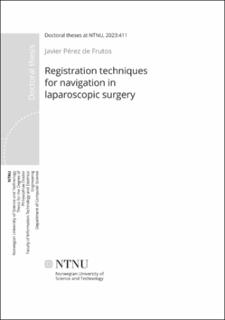| dc.contributor.advisor | Lindseth, Frank | |
| dc.contributor.advisor | Elle, Ole Jacob | |
| dc.contributor.advisor | Langø, Thomas | |
| dc.contributor.author | Pérez de Frutos, Javier | |
| dc.date.accessioned | 2023-12-05T15:15:01Z | |
| dc.date.available | 2023-12-05T15:15:01Z | |
| dc.date.issued | 2023 | |
| dc.identifier.isbn | 978-82-326-7521-0 | |
| dc.identifier.issn | 2703-8084 | |
| dc.identifier.uri | https://hdl.handle.net/11250/3106102 | |
| dc.description.abstract | In minimally invasive surgery, where a direct sight of the treated organ or structures is not feasible but with a laparoscope, image guided systems have been developed to provide the surgeon with real time information of the surgical area, in the form of images of the anatomy of the patient, and surgical navigation. In order to do so, image-to-patient and image-to-image registration techniques are required to bring physical and image information on to the same system of reference. Essentially, both methods rely on point-to-point correspondence, using a collection of selected features on both the fixed and target domains. In the case of image-to-patient, position landmarks are used. Whereas in image-to-image, features related to the intensity information of the image, or the topology of segmentations, are the usual approach. Nevertheless, these procedures require time and are susceptible to human error. In image-to-patient in particular, when sampling landmarks on the patient anatomy. Image-to-image methods on the other hand, operate between different images and virtual models, being complex to implement and to achieve good results, especially in multi-modal setups.
The presented research is framed in the field of hepatocellular carcinoma surgical treatment, the most common type of liver cancer. Wedge resection is the usual choice to remove the cancerous cells, aiming to spare as much healthy tissue as possible while ensuring a complete extraction of the tumor. However, during the intervention, the organ undergoes major deformation due to mobilisation and detachment of the abdominal wall. This deformation is not reflected in the pre-operative images, showing an inaccurate location of relevant anatomical structures as well as the target lesion. Through a laparoscope and laparoscopic ultrasound, the surgeon can build a mental image of the anatomy of the patient during the intervention, adding extra strain on the practitioner. Registration techniques can leverage the procedure outcome and ease the surgery by aligning the virtual models of the patient to the situation on the surgical table. Furthermore, by updating the pre-operative model with the real-time information acquired when inspecting the organ.
In particular, the present study focuses on the use of registration for navigation in minimally invasive interventions, including image-to-patient and image-to-image registration. Main contributions include the evaluation of tracking technologies for surgical navigation; a novel image-to-patient registration method (single landmark registration method) which can take advantage of the laparoscopic ultrasound to improve the registration of the pre-operative images; the use of deep learning for image-to-image registration in medical applications, and development of new training methods; and the research on the influence of human accuracy in landmark sampling during image-to-patient registration, in augmented reality applications for surgical navigation. | en_US |
| dc.language.iso | eng | en_US |
| dc.publisher | NTNU | en_US |
| dc.relation.ispartofseries | Doctoral theses at NTNU;2023:411 | |
| dc.relation.haspart | Paper 1: Teatini, Andrea; Perez de Frutos, Javier; Langø, Thomas; Edwin, Bjørn; Elle, Ole Jacob. Assessment and comparison of target registration accuracy in surgical instrument tracking technologies. IEEE Engineering in Medicine and Biology Society. Conference Proceedings 2018 ;Volum 40th. s. 1845-1848. Copyright © 2018 IEEE. Available at: http://dx.doi.org/10.1109/EMBC.2018.8512671 | en_US |
| dc.relation.haspart | Paper 2: Perez de Frutos, Javier; Hofstad, Erlend Fagertun; Solberg, Ole Vegard; Tangen, Geir Arne; Lindseth, Frank; Langø, Thomas; Elle, Ole Jacob; Mårvik, Ronald. Laboratory test of Single Landmark registration method for ultrasound-based navigation in laparoscopy using an open-source platform. International Journal of Computer Assisted Radiology and Surgery 2018 ;Volum 13.(12) s. 1927-1936. Open Access This article is distributed under the terms of the Creative Commons Attribution 4.0 International License CC BY. Available at: http://dx.doi.org/10.1007/s11548-018-1830-7 | en_US |
| dc.relation.haspart | Paper 3: Teatini, Andrea; Perez de Frutos, Javier; Eigl, Benjamin; Pelanis, Egidijus; Aghayan, Davit; Lai, Marco; Kumar, Rahul Prasanna; Palomar, Rafael; Edwin, Bjørn; Elle, Ole Jacob. Influence of sampling accuracy on augmented reality for laparoscopic image-guided surgery. MITAT. Minimally invasive therapy & allied technologies 2020 s. 1-10. This is an Open Access article distributed under the terms of the Creative Commons Attribution-NonCommercial-NoDerivatives License. Available at: http://dx.doi.org/10.1080/13645706.2020.1727524 | en_US |
| dc.relation.haspart | Paper 4: Perez de Frutos, Javier; Pedersen, Andre; Pelanis, Egidijus; Bouget, David Nicolas Jean-Mar; Survarachakan, Shanmugapriya; Langø, Thomas; Elle, Ole Jakob; Lindseth, Frank. Learning deep abdominal CT registration through adaptive loss weighting and synthetic data generation. PLOS ONE 2023 ;Volum 18.(2). This is an open access article distributed under the terms of the Creative Commons Attribution License CC-BY. Available at: http://dx.doi.org/10.1371/journal.pone.0282110 | en_US |
| dc.title | Registration techniques for navigation in laparascopic surgery | en_US |
| dc.type | Doctoral thesis | en_US |
| dc.subject.nsi | VDP::Teknologi: 500::Informasjons- og kommunikasjonsteknologi: 550 | en_US |
